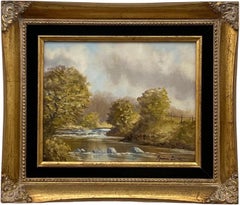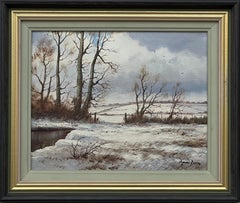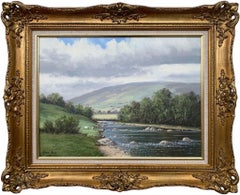Manson Blair
Late 20th Century Realist Landscape Paintings
Canvas, Oil
Late 20th Century Realist Landscape Paintings
Canvas, Oil
Manson BlairOriginal Oil Painting Slemish Mountain County Antrim Ireland by Irish Artist, 1990 Circa
Late 20th Century Realist Landscape Paintings
Oil, Board, Paint, Canvas, Glass
Recent Sales
Late 20th Century Realist Landscape Paintings
Canvas, Oil
Late 20th Century Realist Landscape Paintings
Canvas, Oil
People Also Browsed
Late 20th Century Realist Landscape Paintings
Canvas, Cotton Canvas, Oil
1980s English School Landscape Paintings
Canvas, Cotton Canvas, Oil
1980s Post-Impressionist Landscape Paintings
Canvas, Oil
Late 20th Century Impressionist Landscape Paintings
Canvas, Oil
1980s Realist Landscape Paintings
Oil, Board
1990s Realist Landscape Paintings
Gesso, Canvas, Cotton, Paint, Cotton Canvas, Mixed Media, Oil
Mid-20th Century Realist Landscape Paintings
Canvas, Oil
21st Century and Contemporary Impressionist Landscape Paintings
Oil
Late 20th Century Realist Landscape Paintings
Canvas, Oil
1980s Realist Landscape Paintings
Canvas, Oil
17th Century Old Masters Paintings
Oil
Late 20th Century Impressionist Landscape Paintings
Canvas, Oil
1980s Realist Landscape Paintings
Canvas, Oil
1970s Contemporary Landscape Paintings
Canvas, Oil
Early 20th Century American Impressionist Landscape Paintings
Canvas, Oil
20th Century Realist Landscape Paintings
Canvas, Oil
A Close Look at Realist Art
Realist art attempts to portray its subject matter without artifice. Similar to naturalism, authentic realist paintings and prints see an integration of true-to-life colors, meticulous detail and linear perspectives for accurate portrayals of the world.
Work that involves illusionistic techniques of realism dates back to the classical world, such as the deceptive trompe l’oeil used since ancient Greece. Art like this became especially popular in the 17th century when Dutch artists like Evert Collier painted objects that appeared real enough to touch. Realism as an artistic movement, however, usually refers to 19th-century French realist artists such as Honoré Daumier exploring social and political issues in biting lithographic prints, while the likes of Gustave Courbet and Jean-François Millet painting people — particularly the working class — with all their imperfections, navigating everyday urban life. This was a response to the dominant academic art tradition that favored grand paintings of myth and history.
By the turn of the 20th century, European artists, such as the Pre-Raphaelites, were experimenting with nearly photographic realism in their work, as seen in the attention to every botanical attribute of the flowers surrounding the drowned Ophelia painted by English artist John Everett Millais.
Although abstraction was the guiding style of 20th-century art, the realism trend in American modern art endured in Edward Hopper, Andrew Wyeth and other artists’ depictions of the complexities of the human experience. In the late 1960s, Photorealism emerged with artists like Chuck Close and Richard Estes giving their paintings the precision of a frame of film.
Contemporary artists such as Jordan Casteel, LaToya Ruby Frazier and Aliza Nisenbaum are now using the unvarnished realist approach for honest representations of people and their worlds. Alongside traditional mediums, technology such as virtual reality, artificial intelligence and immersive installations are helping artists create new sensations of realism in art.
Find authentic realist paintings, sculptures, prints and more art on 1stDibs.
Finding the Right Figurative-paintings for You
Figurative art, as opposed to abstract art, retains features from the observable world in its representational depictions of subject matter. Most commonly, figurative paintings reference and explore the human body, but they can also include landscapes, architecture, plants and animals — all portrayed with realism.
While the oldest figurative art dates back tens of thousands of years to cave wall paintings, figurative works made from observation became especially prominent in the early Renaissance. Artists like Michelangelo, Leonardo da Vinci and other Renaissance masters created naturalistic representations of their subjects.
Pablo Picasso is lauded for laying the foundation for modern figurative art in the 1920s. Although abstracted, this work held a strong connection to representing people and other subjects. Other famous figurative artists include Francis Bacon and Lucian Freud. Figurative art in the 20th century would span such diverse genres as Expressionism, Pop art and Surrealism.
Today, a number of figural artists — such as Sedrick Huckaby, Daisy Patton and Eileen Cooper — are making art that uses the human body as its subject.
Because figurative art represents subjects from the real world, natural colors are common in these paintings. A piece of figurative art can be an exciting starting point for setting a tone and creating a color palette in a room.
Browse an extensive collection of figurative paintings on 1stDibs.




